Business and Business Environment
VerifiedAdded on 2023/01/13
|13
|3888
|68
AI Summary
This document provides an overview of the business environment and its impact on organizations. It discusses the different types of organizations and their legal structures. It also explores the functional relationships within organizations and their link to objectives and structure. Additionally, it analyzes the positive and negative aspects of PESTLE and conducts SWOT analysis of organizations.
Contribute Materials
Your contribution can guide someone’s learning journey. Share your
documents today.
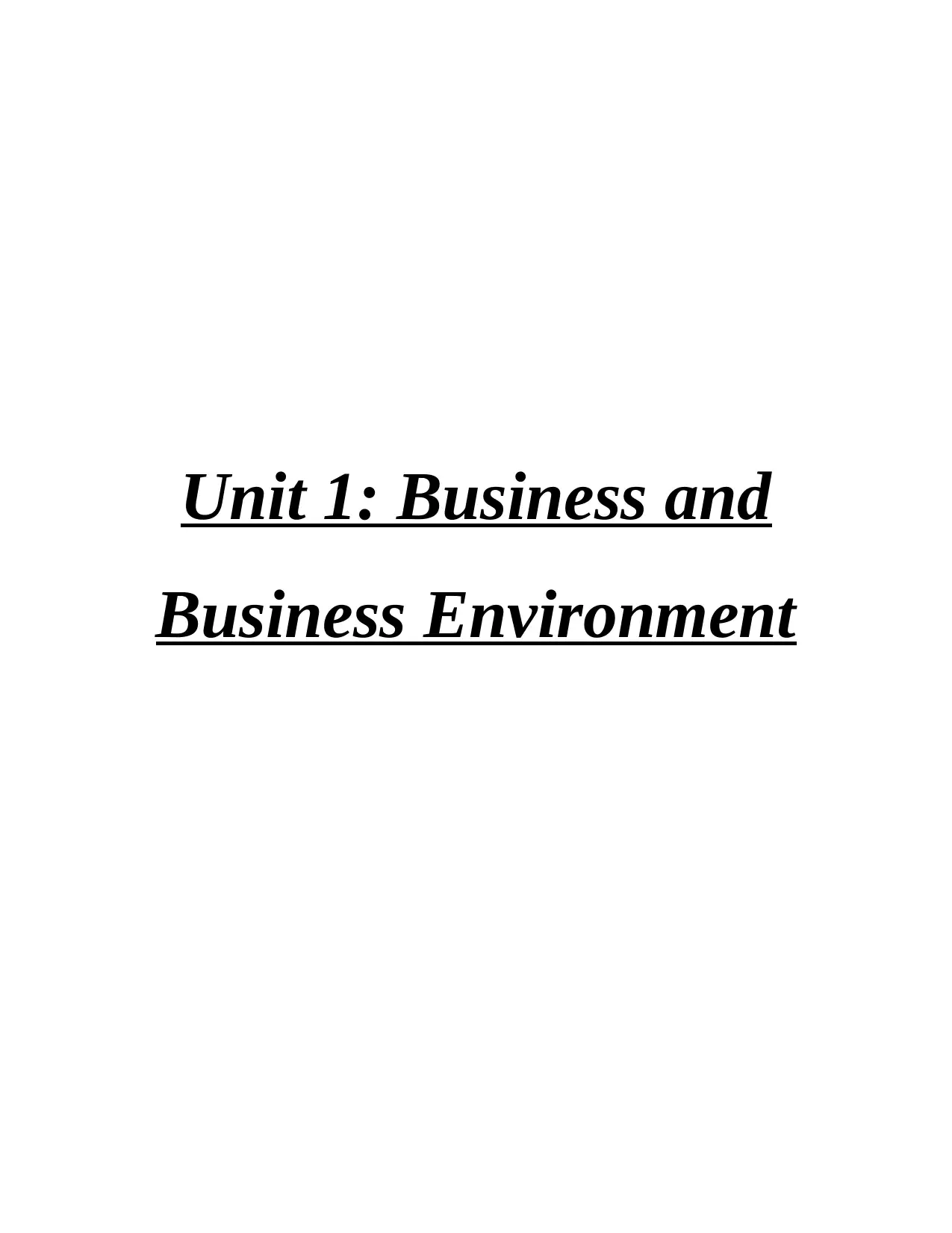
Unit 1: Business and
Business Environment
Business Environment
Secure Best Marks with AI Grader
Need help grading? Try our AI Grader for instant feedback on your assignments.
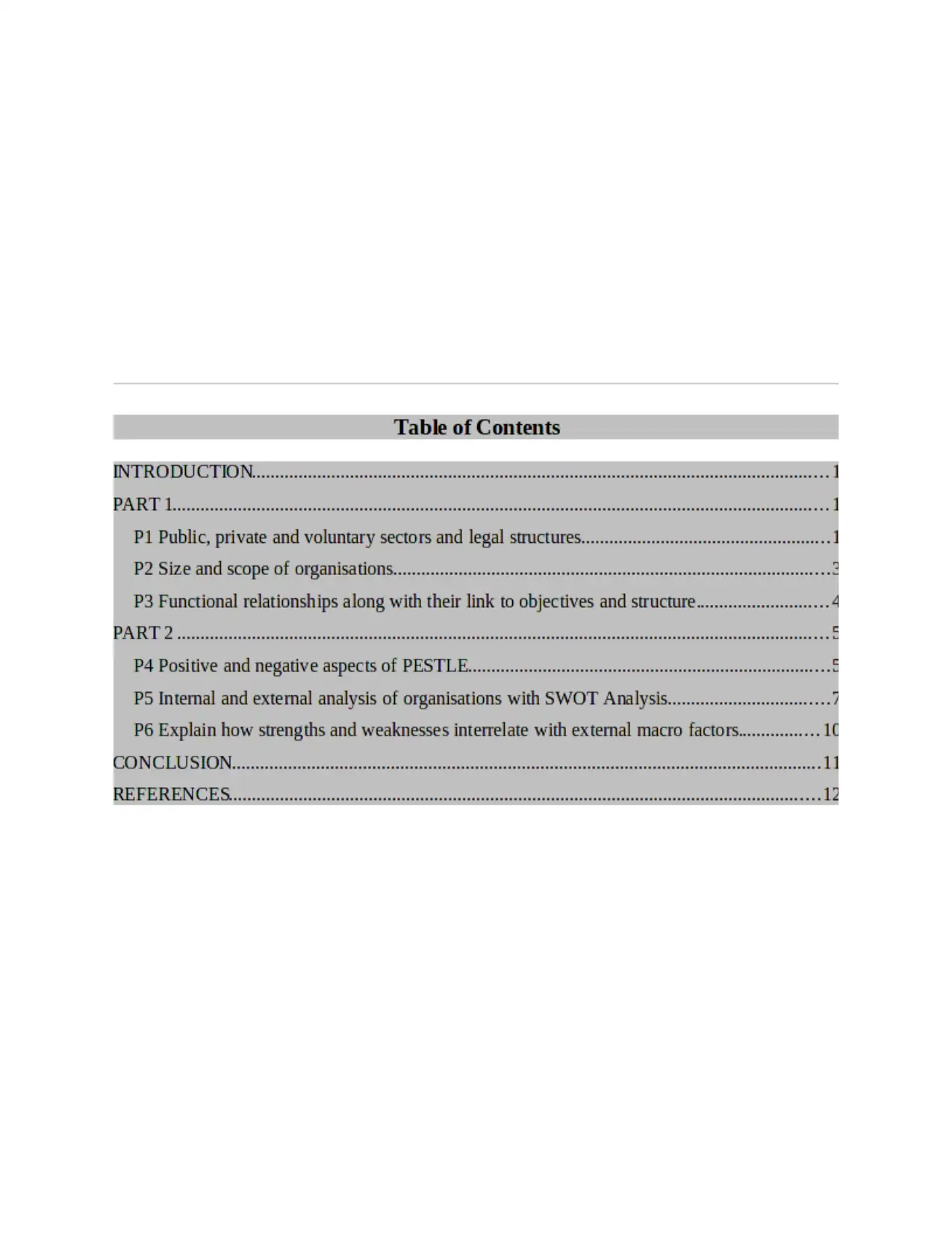
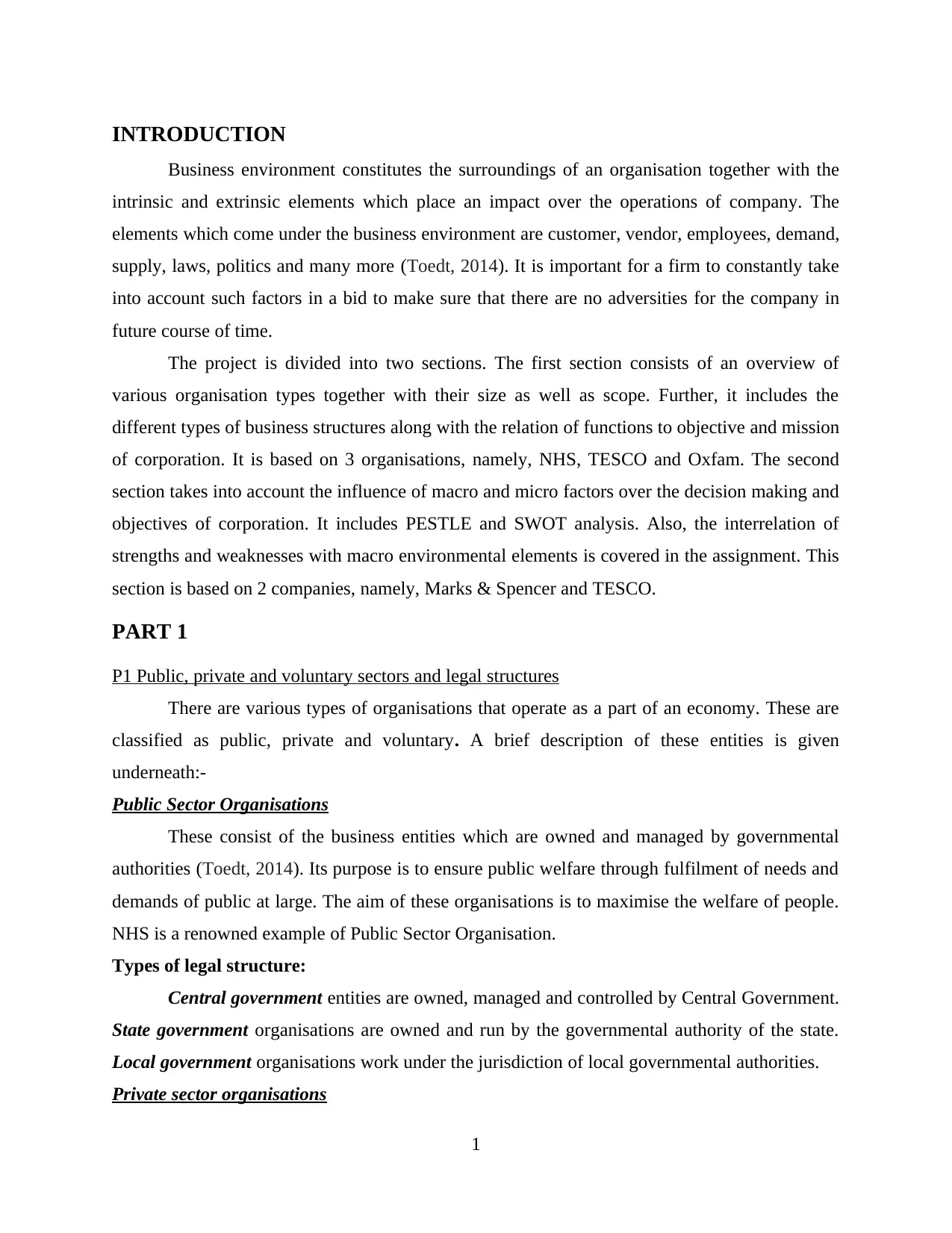
INTRODUCTION
Business environment constitutes the surroundings of an organisation together with the
intrinsic and extrinsic elements which place an impact over the operations of company. The
elements which come under the business environment are customer, vendor, employees, demand,
supply, laws, politics and many more (Toedt, 2014). It is important for a firm to constantly take
into account such factors in a bid to make sure that there are no adversities for the company in
future course of time.
The project is divided into two sections. The first section consists of an overview of
various organisation types together with their size as well as scope. Further, it includes the
different types of business structures along with the relation of functions to objective and mission
of corporation. It is based on 3 organisations, namely, NHS, TESCO and Oxfam. The second
section takes into account the influence of macro and micro factors over the decision making and
objectives of corporation. It includes PESTLE and SWOT analysis. Also, the interrelation of
strengths and weaknesses with macro environmental elements is covered in the assignment. This
section is based on 2 companies, namely, Marks & Spencer and TESCO.
PART 1
P1 Public, private and voluntary sectors and legal structures
There are various types of organisations that operate as a part of an economy. These are
classified as public, private and voluntary. A brief description of these entities is given
underneath:-
Public Sector Organisations
These consist of the business entities which are owned and managed by governmental
authorities (Toedt, 2014). Its purpose is to ensure public welfare through fulfilment of needs and
demands of public at large. The aim of these organisations is to maximise the welfare of people.
NHS is a renowned example of Public Sector Organisation.
Types of legal structure:
Central government entities are owned, managed and controlled by Central Government.
State government organisations are owned and run by the governmental authority of the state.
Local government organisations work under the jurisdiction of local governmental authorities.
Private sector organisations
1
Business environment constitutes the surroundings of an organisation together with the
intrinsic and extrinsic elements which place an impact over the operations of company. The
elements which come under the business environment are customer, vendor, employees, demand,
supply, laws, politics and many more (Toedt, 2014). It is important for a firm to constantly take
into account such factors in a bid to make sure that there are no adversities for the company in
future course of time.
The project is divided into two sections. The first section consists of an overview of
various organisation types together with their size as well as scope. Further, it includes the
different types of business structures along with the relation of functions to objective and mission
of corporation. It is based on 3 organisations, namely, NHS, TESCO and Oxfam. The second
section takes into account the influence of macro and micro factors over the decision making and
objectives of corporation. It includes PESTLE and SWOT analysis. Also, the interrelation of
strengths and weaknesses with macro environmental elements is covered in the assignment. This
section is based on 2 companies, namely, Marks & Spencer and TESCO.
PART 1
P1 Public, private and voluntary sectors and legal structures
There are various types of organisations that operate as a part of an economy. These are
classified as public, private and voluntary. A brief description of these entities is given
underneath:-
Public Sector Organisations
These consist of the business entities which are owned and managed by governmental
authorities (Toedt, 2014). Its purpose is to ensure public welfare through fulfilment of needs and
demands of public at large. The aim of these organisations is to maximise the welfare of people.
NHS is a renowned example of Public Sector Organisation.
Types of legal structure:
Central government entities are owned, managed and controlled by Central Government.
State government organisations are owned and run by the governmental authority of the state.
Local government organisations work under the jurisdiction of local governmental authorities.
Private sector organisations
1
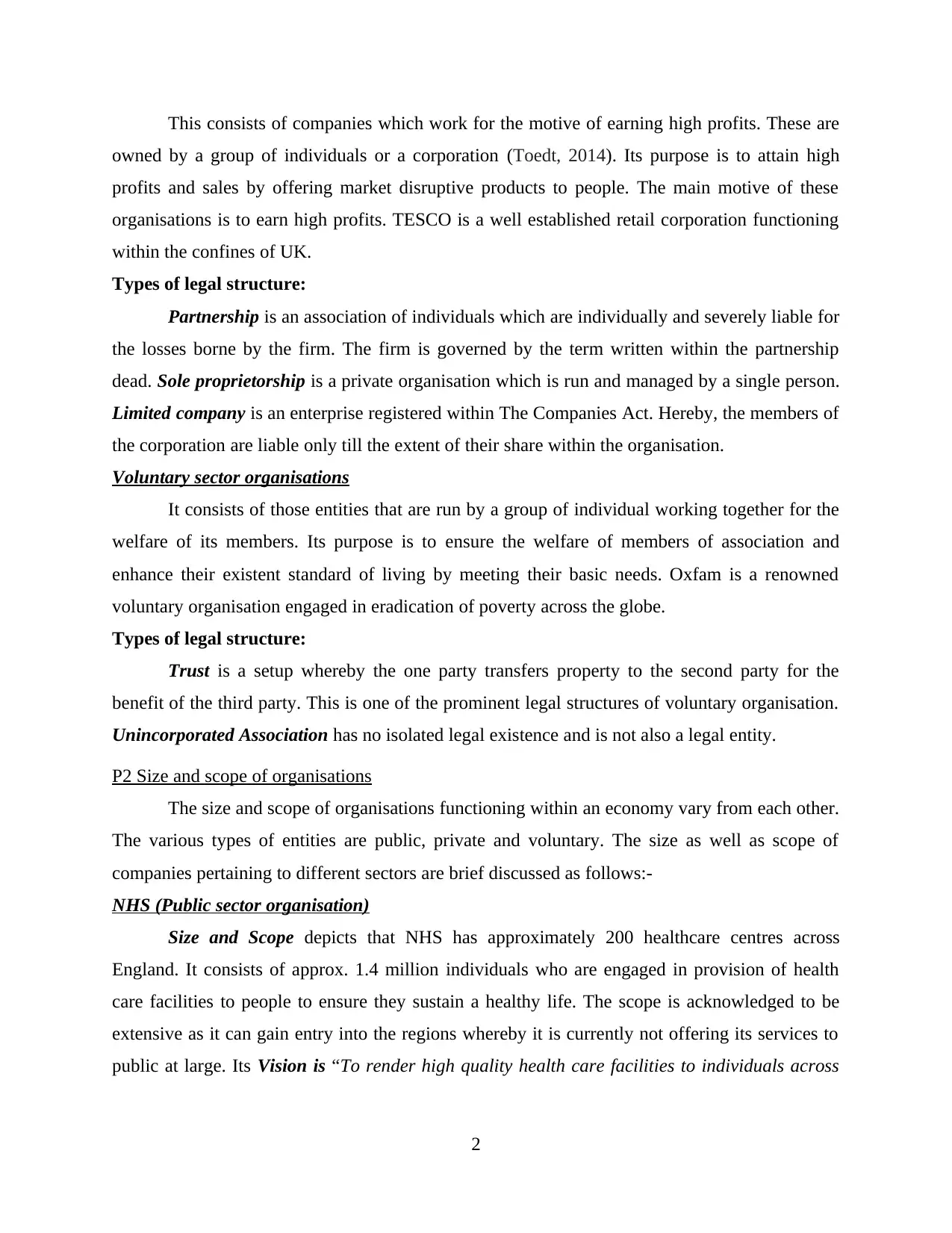
This consists of companies which work for the motive of earning high profits. These are
owned by a group of individuals or a corporation (Toedt, 2014). Its purpose is to attain high
profits and sales by offering market disruptive products to people. The main motive of these
organisations is to earn high profits. TESCO is a well established retail corporation functioning
within the confines of UK.
Types of legal structure:
Partnership is an association of individuals which are individually and severely liable for
the losses borne by the firm. The firm is governed by the term written within the partnership
dead. Sole proprietorship is a private organisation which is run and managed by a single person.
Limited company is an enterprise registered within The Companies Act. Hereby, the members of
the corporation are liable only till the extent of their share within the organisation.
Voluntary sector organisations
It consists of those entities that are run by a group of individual working together for the
welfare of its members. Its purpose is to ensure the welfare of members of association and
enhance their existent standard of living by meeting their basic needs. Oxfam is a renowned
voluntary organisation engaged in eradication of poverty across the globe.
Types of legal structure:
Trust is a setup whereby the one party transfers property to the second party for the
benefit of the third party. This is one of the prominent legal structures of voluntary organisation.
Unincorporated Association has no isolated legal existence and is not also a legal entity.
P2 Size and scope of organisations
The size and scope of organisations functioning within an economy vary from each other.
The various types of entities are public, private and voluntary. The size as well as scope of
companies pertaining to different sectors are brief discussed as follows:-
NHS (Public sector organisation)
Size and Scope depicts that NHS has approximately 200 healthcare centres across
England. It consists of approx. 1.4 million individuals who are engaged in provision of health
care facilities to people to ensure they sustain a healthy life. The scope is acknowledged to be
extensive as it can gain entry into the regions whereby it is currently not offering its services to
public at large. Its Vision is “To render high quality health care facilities to individuals across
2
owned by a group of individuals or a corporation (Toedt, 2014). Its purpose is to attain high
profits and sales by offering market disruptive products to people. The main motive of these
organisations is to earn high profits. TESCO is a well established retail corporation functioning
within the confines of UK.
Types of legal structure:
Partnership is an association of individuals which are individually and severely liable for
the losses borne by the firm. The firm is governed by the term written within the partnership
dead. Sole proprietorship is a private organisation which is run and managed by a single person.
Limited company is an enterprise registered within The Companies Act. Hereby, the members of
the corporation are liable only till the extent of their share within the organisation.
Voluntary sector organisations
It consists of those entities that are run by a group of individual working together for the
welfare of its members. Its purpose is to ensure the welfare of members of association and
enhance their existent standard of living by meeting their basic needs. Oxfam is a renowned
voluntary organisation engaged in eradication of poverty across the globe.
Types of legal structure:
Trust is a setup whereby the one party transfers property to the second party for the
benefit of the third party. This is one of the prominent legal structures of voluntary organisation.
Unincorporated Association has no isolated legal existence and is not also a legal entity.
P2 Size and scope of organisations
The size and scope of organisations functioning within an economy vary from each other.
The various types of entities are public, private and voluntary. The size as well as scope of
companies pertaining to different sectors are brief discussed as follows:-
NHS (Public sector organisation)
Size and Scope depicts that NHS has approximately 200 healthcare centres across
England. It consists of approx. 1.4 million individuals who are engaged in provision of health
care facilities to people to ensure they sustain a healthy life. The scope is acknowledged to be
extensive as it can gain entry into the regions whereby it is currently not offering its services to
public at large. Its Vision is “To render high quality health care facilities to individuals across
2
Secure Best Marks with AI Grader
Need help grading? Try our AI Grader for instant feedback on your assignments.
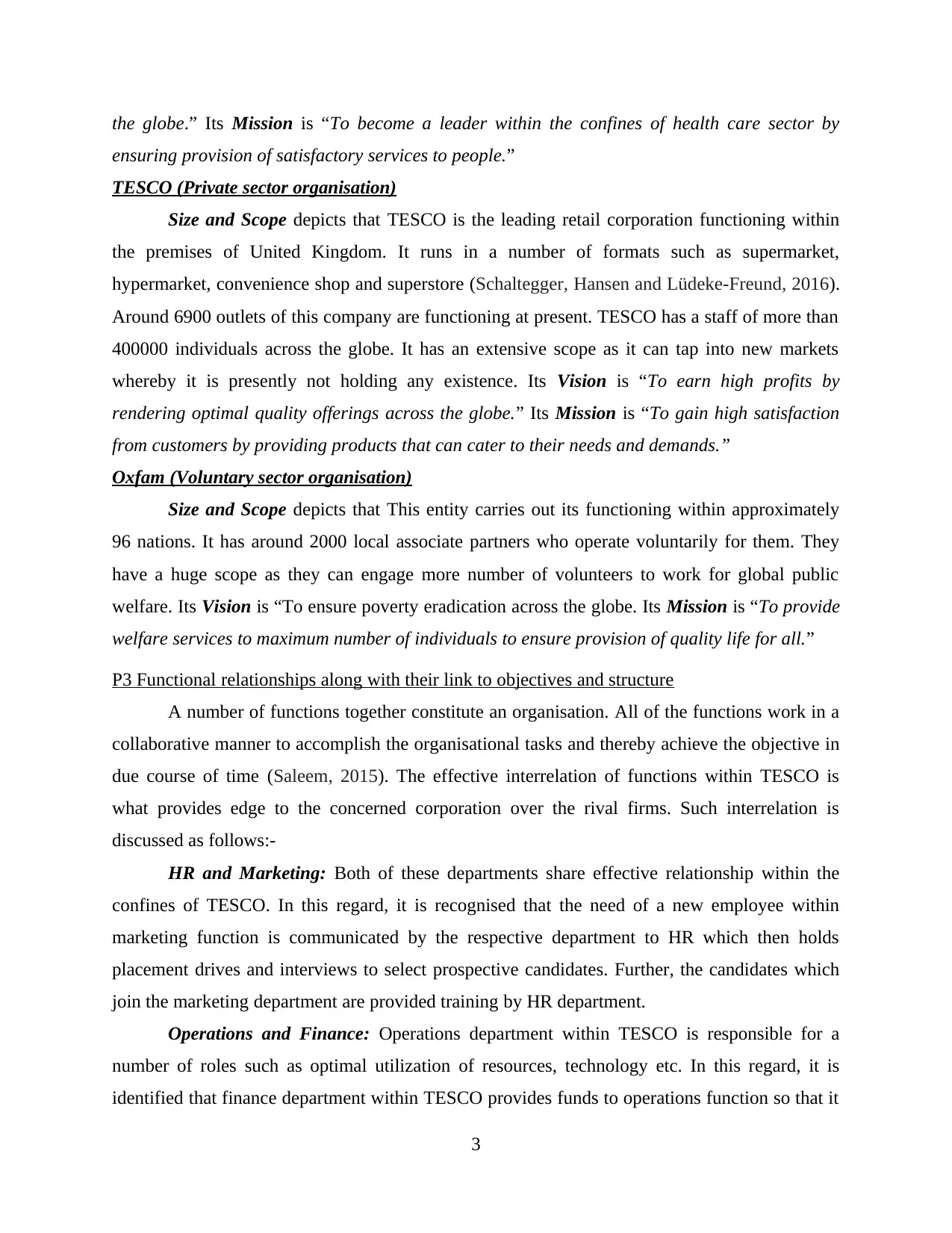
the globe.” Its Mission is “To become a leader within the confines of health care sector by
ensuring provision of satisfactory services to people.”
TESCO (Private sector organisation)
Size and Scope depicts that TESCO is the leading retail corporation functioning within
the premises of United Kingdom. It runs in a number of formats such as supermarket,
hypermarket, convenience shop and superstore (Schaltegger, Hansen and Lüdeke-Freund, 2016).
Around 6900 outlets of this company are functioning at present. TESCO has a staff of more than
400000 individuals across the globe. It has an extensive scope as it can tap into new markets
whereby it is presently not holding any existence. Its Vision is “To earn high profits by
rendering optimal quality offerings across the globe.” Its Mission is “To gain high satisfaction
from customers by providing products that can cater to their needs and demands.”
Oxfam (Voluntary sector organisation)
Size and Scope depicts that This entity carries out its functioning within approximately
96 nations. It has around 2000 local associate partners who operate voluntarily for them. They
have a huge scope as they can engage more number of volunteers to work for global public
welfare. Its Vision is “To ensure poverty eradication across the globe. Its Mission is “To provide
welfare services to maximum number of individuals to ensure provision of quality life for all.”
P3 Functional relationships along with their link to objectives and structure
A number of functions together constitute an organisation. All of the functions work in a
collaborative manner to accomplish the organisational tasks and thereby achieve the objective in
due course of time (Saleem, 2015). The effective interrelation of functions within TESCO is
what provides edge to the concerned corporation over the rival firms. Such interrelation is
discussed as follows:-
HR and Marketing: Both of these departments share effective relationship within the
confines of TESCO. In this regard, it is recognised that the need of a new employee within
marketing function is communicated by the respective department to HR which then holds
placement drives and interviews to select prospective candidates. Further, the candidates which
join the marketing department are provided training by HR department.
Operations and Finance: Operations department within TESCO is responsible for a
number of roles such as optimal utilization of resources, technology etc. In this regard, it is
identified that finance department within TESCO provides funds to operations function so that it
3
ensuring provision of satisfactory services to people.”
TESCO (Private sector organisation)
Size and Scope depicts that TESCO is the leading retail corporation functioning within
the premises of United Kingdom. It runs in a number of formats such as supermarket,
hypermarket, convenience shop and superstore (Schaltegger, Hansen and Lüdeke-Freund, 2016).
Around 6900 outlets of this company are functioning at present. TESCO has a staff of more than
400000 individuals across the globe. It has an extensive scope as it can tap into new markets
whereby it is presently not holding any existence. Its Vision is “To earn high profits by
rendering optimal quality offerings across the globe.” Its Mission is “To gain high satisfaction
from customers by providing products that can cater to their needs and demands.”
Oxfam (Voluntary sector organisation)
Size and Scope depicts that This entity carries out its functioning within approximately
96 nations. It has around 2000 local associate partners who operate voluntarily for them. They
have a huge scope as they can engage more number of volunteers to work for global public
welfare. Its Vision is “To ensure poverty eradication across the globe. Its Mission is “To provide
welfare services to maximum number of individuals to ensure provision of quality life for all.”
P3 Functional relationships along with their link to objectives and structure
A number of functions together constitute an organisation. All of the functions work in a
collaborative manner to accomplish the organisational tasks and thereby achieve the objective in
due course of time (Saleem, 2015). The effective interrelation of functions within TESCO is
what provides edge to the concerned corporation over the rival firms. Such interrelation is
discussed as follows:-
HR and Marketing: Both of these departments share effective relationship within the
confines of TESCO. In this regard, it is recognised that the need of a new employee within
marketing function is communicated by the respective department to HR which then holds
placement drives and interviews to select prospective candidates. Further, the candidates which
join the marketing department are provided training by HR department.
Operations and Finance: Operations department within TESCO is responsible for a
number of roles such as optimal utilization of resources, technology etc. In this regard, it is
identified that finance department within TESCO provides funds to operations function so that it
3
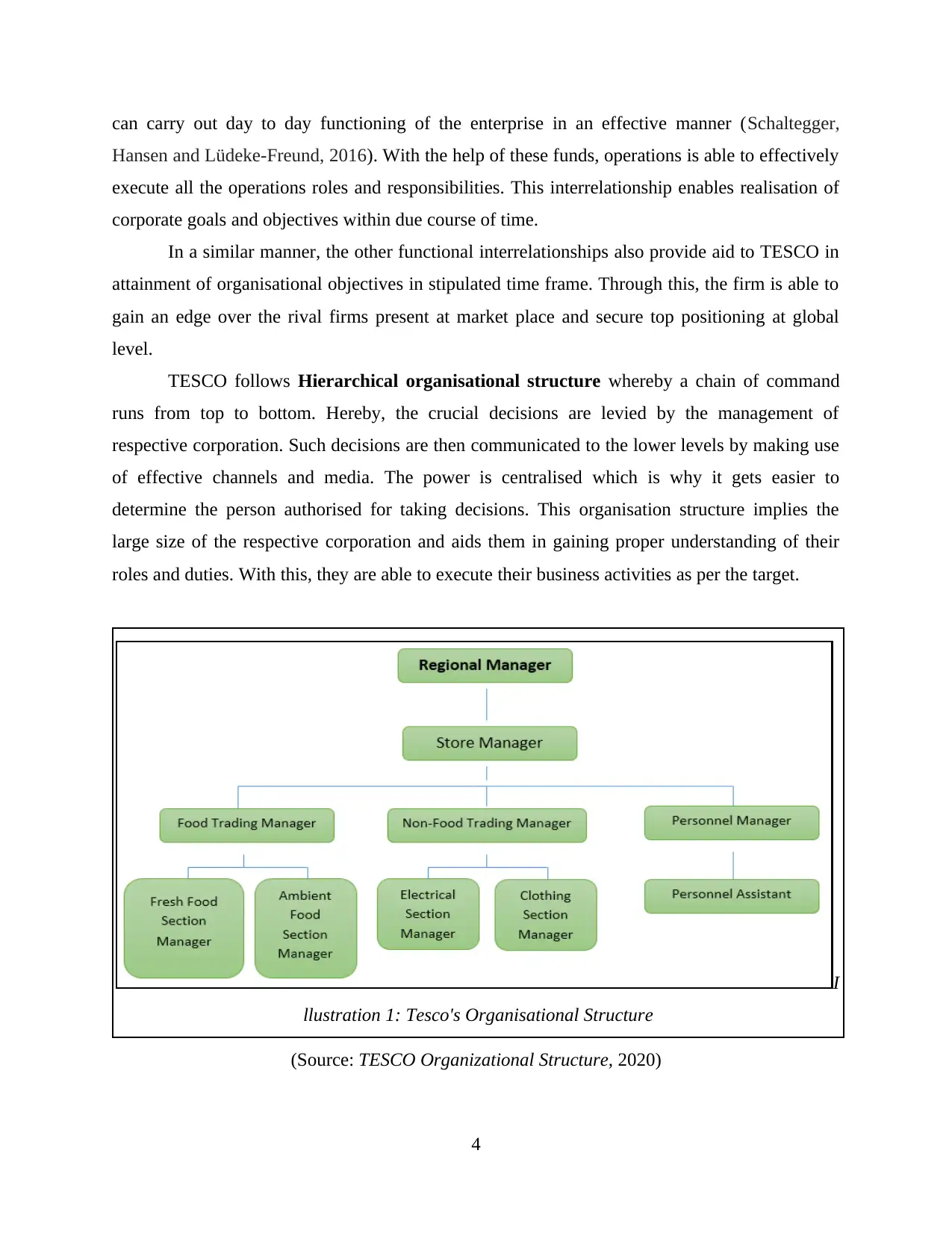
can carry out day to day functioning of the enterprise in an effective manner (Schaltegger,
Hansen and Lüdeke-Freund, 2016). With the help of these funds, operations is able to effectively
execute all the operations roles and responsibilities. This interrelationship enables realisation of
corporate goals and objectives within due course of time.
In a similar manner, the other functional interrelationships also provide aid to TESCO in
attainment of organisational objectives in stipulated time frame. Through this, the firm is able to
gain an edge over the rival firms present at market place and secure top positioning at global
level.
TESCO follows Hierarchical organisational structure whereby a chain of command
runs from top to bottom. Hereby, the crucial decisions are levied by the management of
respective corporation. Such decisions are then communicated to the lower levels by making use
of effective channels and media. The power is centralised which is why it gets easier to
determine the person authorised for taking decisions. This organisation structure implies the
large size of the respective corporation and aids them in gaining proper understanding of their
roles and duties. With this, they are able to execute their business activities as per the target.
I
llustration 1: Tesco's Organisational Structure
(Source: TESCO Organizational Structure, 2020)
4
Hansen and Lüdeke-Freund, 2016). With the help of these funds, operations is able to effectively
execute all the operations roles and responsibilities. This interrelationship enables realisation of
corporate goals and objectives within due course of time.
In a similar manner, the other functional interrelationships also provide aid to TESCO in
attainment of organisational objectives in stipulated time frame. Through this, the firm is able to
gain an edge over the rival firms present at market place and secure top positioning at global
level.
TESCO follows Hierarchical organisational structure whereby a chain of command
runs from top to bottom. Hereby, the crucial decisions are levied by the management of
respective corporation. Such decisions are then communicated to the lower levels by making use
of effective channels and media. The power is centralised which is why it gets easier to
determine the person authorised for taking decisions. This organisation structure implies the
large size of the respective corporation and aids them in gaining proper understanding of their
roles and duties. With this, they are able to execute their business activities as per the target.
I
llustration 1: Tesco's Organisational Structure
(Source: TESCO Organizational Structure, 2020)
4
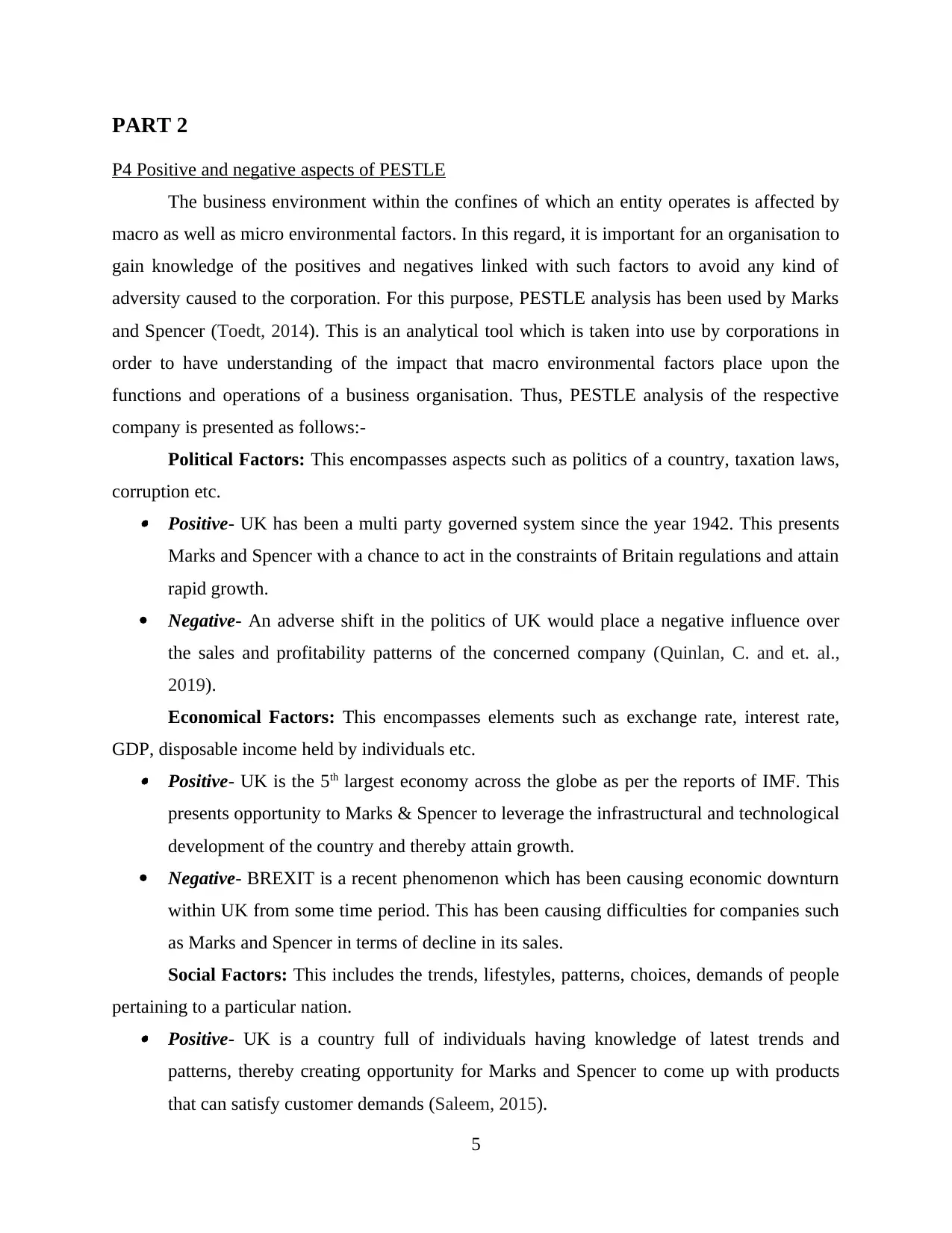
PART 2
P4 Positive and negative aspects of PESTLE
The business environment within the confines of which an entity operates is affected by
macro as well as micro environmental factors. In this regard, it is important for an organisation to
gain knowledge of the positives and negatives linked with such factors to avoid any kind of
adversity caused to the corporation. For this purpose, PESTLE analysis has been used by Marks
and Spencer (Toedt, 2014). This is an analytical tool which is taken into use by corporations in
order to have understanding of the impact that macro environmental factors place upon the
functions and operations of a business organisation. Thus, PESTLE analysis of the respective
company is presented as follows:-
Political Factors: This encompasses aspects such as politics of a country, taxation laws,
corruption etc. Positive- UK has been a multi party governed system since the year 1942. This presents
Marks and Spencer with a chance to act in the constraints of Britain regulations and attain
rapid growth.
Negative- An adverse shift in the politics of UK would place a negative influence over
the sales and profitability patterns of the concerned company (Quinlan, C. and et. al.,
2019).
Economical Factors: This encompasses elements such as exchange rate, interest rate,
GDP, disposable income held by individuals etc. Positive- UK is the 5th largest economy across the globe as per the reports of IMF. This
presents opportunity to Marks & Spencer to leverage the infrastructural and technological
development of the country and thereby attain growth.
Negative- BREXIT is a recent phenomenon which has been causing economic downturn
within UK from some time period. This has been causing difficulties for companies such
as Marks and Spencer in terms of decline in its sales.
Social Factors: This includes the trends, lifestyles, patterns, choices, demands of people
pertaining to a particular nation. Positive- UK is a country full of individuals having knowledge of latest trends and
patterns, thereby creating opportunity for Marks and Spencer to come up with products
that can satisfy customer demands (Saleem, 2015).
5
P4 Positive and negative aspects of PESTLE
The business environment within the confines of which an entity operates is affected by
macro as well as micro environmental factors. In this regard, it is important for an organisation to
gain knowledge of the positives and negatives linked with such factors to avoid any kind of
adversity caused to the corporation. For this purpose, PESTLE analysis has been used by Marks
and Spencer (Toedt, 2014). This is an analytical tool which is taken into use by corporations in
order to have understanding of the impact that macro environmental factors place upon the
functions and operations of a business organisation. Thus, PESTLE analysis of the respective
company is presented as follows:-
Political Factors: This encompasses aspects such as politics of a country, taxation laws,
corruption etc. Positive- UK has been a multi party governed system since the year 1942. This presents
Marks and Spencer with a chance to act in the constraints of Britain regulations and attain
rapid growth.
Negative- An adverse shift in the politics of UK would place a negative influence over
the sales and profitability patterns of the concerned company (Quinlan, C. and et. al.,
2019).
Economical Factors: This encompasses elements such as exchange rate, interest rate,
GDP, disposable income held by individuals etc. Positive- UK is the 5th largest economy across the globe as per the reports of IMF. This
presents opportunity to Marks & Spencer to leverage the infrastructural and technological
development of the country and thereby attain growth.
Negative- BREXIT is a recent phenomenon which has been causing economic downturn
within UK from some time period. This has been causing difficulties for companies such
as Marks and Spencer in terms of decline in its sales.
Social Factors: This includes the trends, lifestyles, patterns, choices, demands of people
pertaining to a particular nation. Positive- UK is a country full of individuals having knowledge of latest trends and
patterns, thereby creating opportunity for Marks and Spencer to come up with products
that can satisfy customer demands (Saleem, 2015).
5
Paraphrase This Document
Need a fresh take? Get an instant paraphrase of this document with our AI Paraphraser

Negative- Whereby the firm undertakes constant market research to gain knowledge of
the latest trends and patterns of customers, it would inflate the overall cost of operations
for Marks and Spencer.
Technological Factors: This encompasses the progressions that take place in trends and
technologies over the course of time. Positive- UK is a technologically progressed country which presents opportunities in
front of Marks and Spencer to make use of latest technological trends and gain high
customers satisfaction.
Negative- Whenever Marks and Spencer takes the initiative to come up with new
technologies aligned with the market, it inflates the overall cost for the company, thereby
creating financial imbalance within its confines.
Legal Factors: This encompasses the legal rules and legislations which have to be
followed by the companies functioning within a nation (Brown, 2018). Positive- Marks and Spencer complies with the laws and legislation applicable within
UK to ensure its long term sustainability at market place.
Negative- An instance whereby the entity works against the provisions of any of the
laws, it would have repercussions for the company in terms of decline in sales.
Environmental Factors: This constitutes environmental laws which need to be complied
with, by the corporation to ensure long term sustainability at market place. Positive- Marks & Spencer makes use of eco-friendly practices to gain support from
customers as well as community. Further, it invests in CSR activities on a regular basis.
Negative- The non adherence to the environmental regulations of UK would dampen the
goodwill of Marks and Spencer at market place.
P5 Internal and external analysis of organisations with SWOT Analysis
SWOT analysis is a business management tool that can be applied by organisations with
a view to gain knowledge of the internal aspects of a corporation (Bah and Fang, 2015). This is
an effective analytical model which is applied to take crucial organisational decisions associated
with stipulation of strategies and tactics for business growth. The management of Marks &
Spencer and TESCO have applied this model to gain comprehensibility of internal environment
of company.
SWOT of Marks & Spencer:
6
the latest trends and patterns of customers, it would inflate the overall cost of operations
for Marks and Spencer.
Technological Factors: This encompasses the progressions that take place in trends and
technologies over the course of time. Positive- UK is a technologically progressed country which presents opportunities in
front of Marks and Spencer to make use of latest technological trends and gain high
customers satisfaction.
Negative- Whenever Marks and Spencer takes the initiative to come up with new
technologies aligned with the market, it inflates the overall cost for the company, thereby
creating financial imbalance within its confines.
Legal Factors: This encompasses the legal rules and legislations which have to be
followed by the companies functioning within a nation (Brown, 2018). Positive- Marks and Spencer complies with the laws and legislation applicable within
UK to ensure its long term sustainability at market place.
Negative- An instance whereby the entity works against the provisions of any of the
laws, it would have repercussions for the company in terms of decline in sales.
Environmental Factors: This constitutes environmental laws which need to be complied
with, by the corporation to ensure long term sustainability at market place. Positive- Marks & Spencer makes use of eco-friendly practices to gain support from
customers as well as community. Further, it invests in CSR activities on a regular basis.
Negative- The non adherence to the environmental regulations of UK would dampen the
goodwill of Marks and Spencer at market place.
P5 Internal and external analysis of organisations with SWOT Analysis
SWOT analysis is a business management tool that can be applied by organisations with
a view to gain knowledge of the internal aspects of a corporation (Bah and Fang, 2015). This is
an effective analytical model which is applied to take crucial organisational decisions associated
with stipulation of strategies and tactics for business growth. The management of Marks &
Spencer and TESCO have applied this model to gain comprehensibility of internal environment
of company.
SWOT of Marks & Spencer:
6
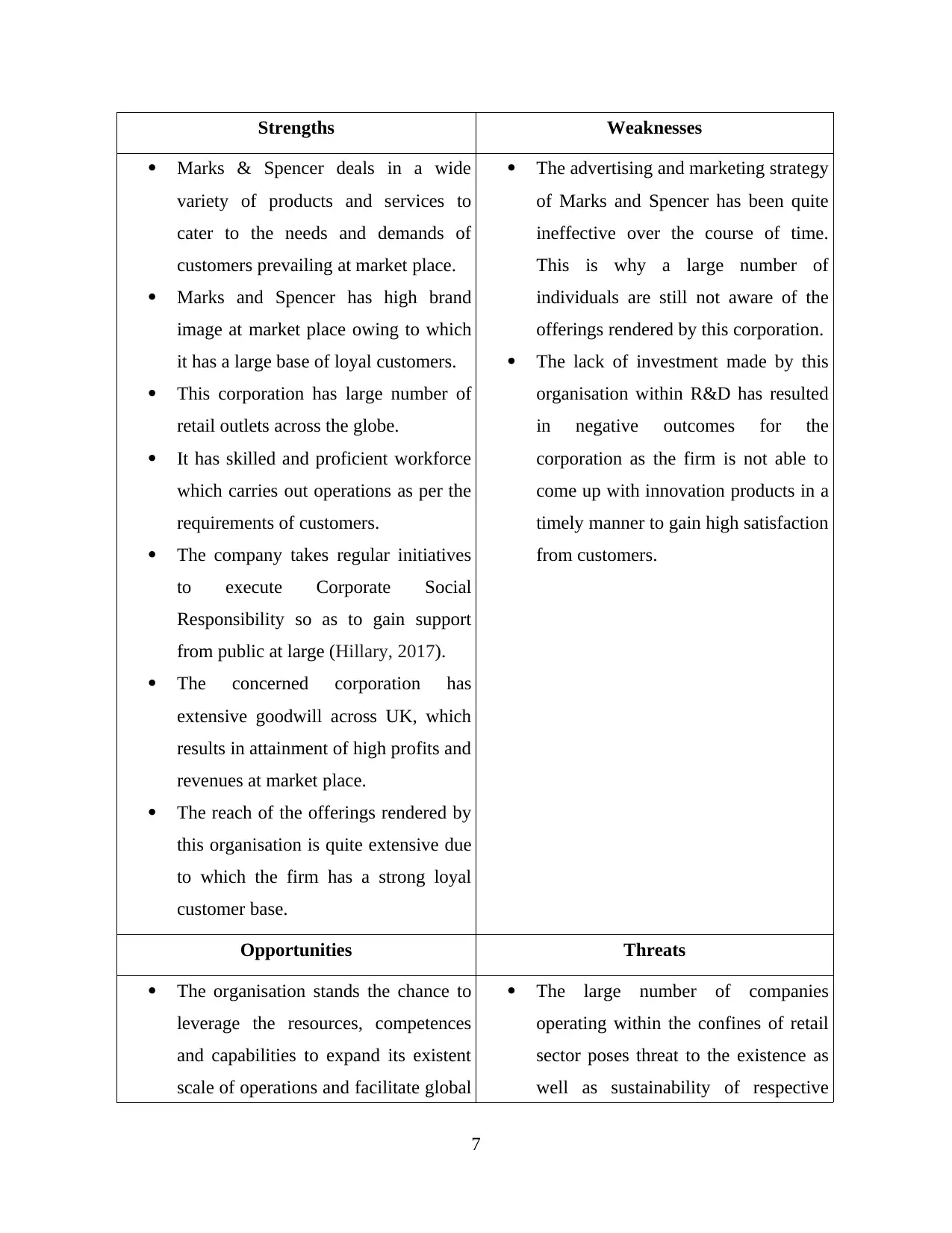
Strengths Weaknesses
Marks & Spencer deals in a wide
variety of products and services to
cater to the needs and demands of
customers prevailing at market place.
Marks and Spencer has high brand
image at market place owing to which
it has a large base of loyal customers.
This corporation has large number of
retail outlets across the globe.
It has skilled and proficient workforce
which carries out operations as per the
requirements of customers.
The company takes regular initiatives
to execute Corporate Social
Responsibility so as to gain support
from public at large (Hillary, 2017).
The concerned corporation has
extensive goodwill across UK, which
results in attainment of high profits and
revenues at market place.
The reach of the offerings rendered by
this organisation is quite extensive due
to which the firm has a strong loyal
customer base.
The advertising and marketing strategy
of Marks and Spencer has been quite
ineffective over the course of time.
This is why a large number of
individuals are still not aware of the
offerings rendered by this corporation.
The lack of investment made by this
organisation within R&D has resulted
in negative outcomes for the
corporation as the firm is not able to
come up with innovation products in a
timely manner to gain high satisfaction
from customers.
Opportunities Threats
The organisation stands the chance to
leverage the resources, competences
and capabilities to expand its existent
scale of operations and facilitate global
The large number of companies
operating within the confines of retail
sector poses threat to the existence as
well as sustainability of respective
7
Marks & Spencer deals in a wide
variety of products and services to
cater to the needs and demands of
customers prevailing at market place.
Marks and Spencer has high brand
image at market place owing to which
it has a large base of loyal customers.
This corporation has large number of
retail outlets across the globe.
It has skilled and proficient workforce
which carries out operations as per the
requirements of customers.
The company takes regular initiatives
to execute Corporate Social
Responsibility so as to gain support
from public at large (Hillary, 2017).
The concerned corporation has
extensive goodwill across UK, which
results in attainment of high profits and
revenues at market place.
The reach of the offerings rendered by
this organisation is quite extensive due
to which the firm has a strong loyal
customer base.
The advertising and marketing strategy
of Marks and Spencer has been quite
ineffective over the course of time.
This is why a large number of
individuals are still not aware of the
offerings rendered by this corporation.
The lack of investment made by this
organisation within R&D has resulted
in negative outcomes for the
corporation as the firm is not able to
come up with innovation products in a
timely manner to gain high satisfaction
from customers.
Opportunities Threats
The organisation stands the chance to
leverage the resources, competences
and capabilities to expand its existent
scale of operations and facilitate global
The large number of companies
operating within the confines of retail
sector poses threat to the existence as
well as sustainability of respective
7
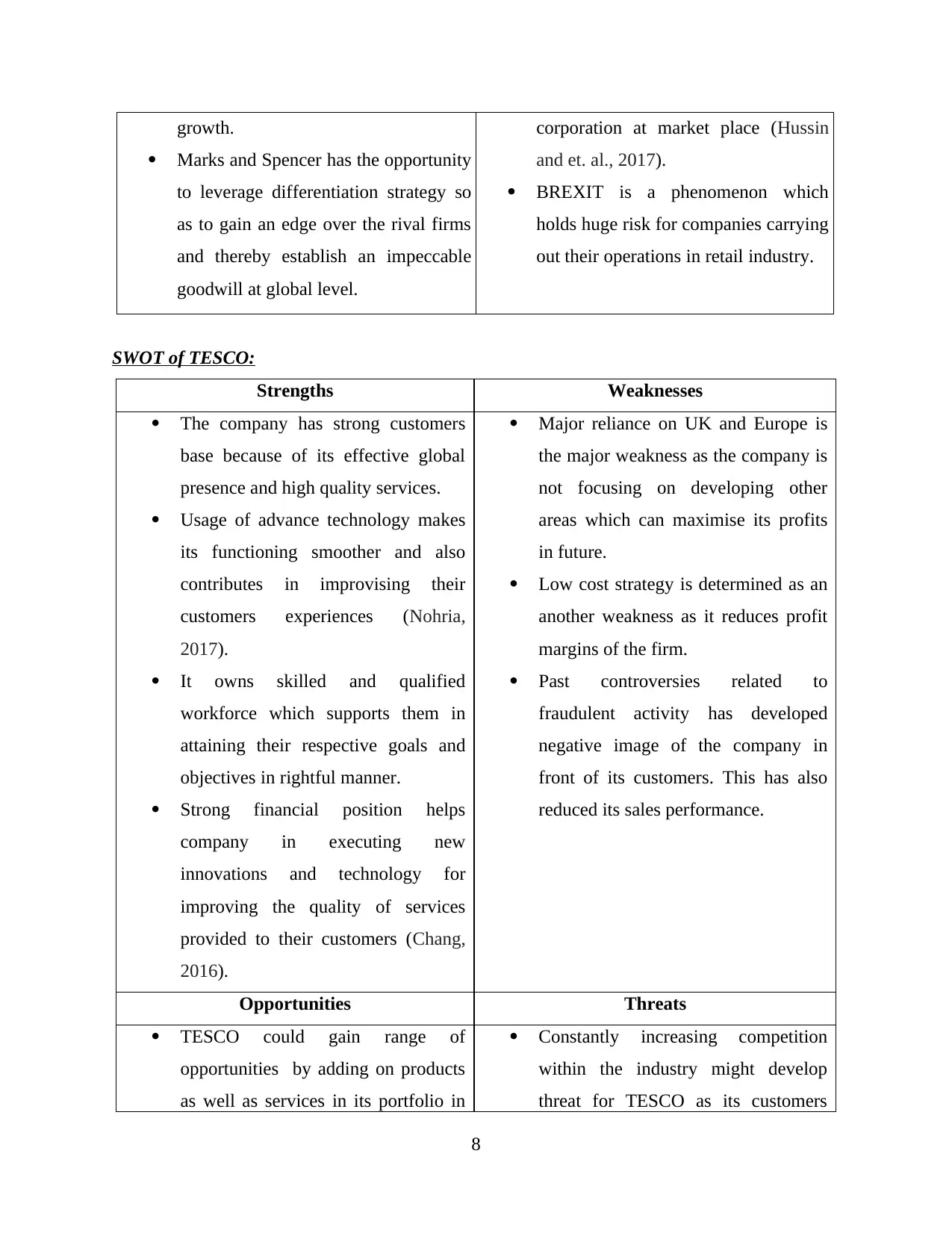
growth.
Marks and Spencer has the opportunity
to leverage differentiation strategy so
as to gain an edge over the rival firms
and thereby establish an impeccable
goodwill at global level.
corporation at market place (Hussin
and et. al., 2017).
BREXIT is a phenomenon which
holds huge risk for companies carrying
out their operations in retail industry.
SWOT of TESCO:
Strengths Weaknesses
The company has strong customers
base because of its effective global
presence and high quality services.
Usage of advance technology makes
its functioning smoother and also
contributes in improvising their
customers experiences (Nohria,
2017).
It owns skilled and qualified
workforce which supports them in
attaining their respective goals and
objectives in rightful manner.
Strong financial position helps
company in executing new
innovations and technology for
improving the quality of services
provided to their customers (Chang,
2016).
Major reliance on UK and Europe is
the major weakness as the company is
not focusing on developing other
areas which can maximise its profits
in future.
Low cost strategy is determined as an
another weakness as it reduces profit
margins of the firm.
Past controversies related to
fraudulent activity has developed
negative image of the company in
front of its customers. This has also
reduced its sales performance.
Opportunities Threats
TESCO could gain range of
opportunities by adding on products
as well as services in its portfolio in
Constantly increasing competition
within the industry might develop
threat for TESCO as its customers
8
Marks and Spencer has the opportunity
to leverage differentiation strategy so
as to gain an edge over the rival firms
and thereby establish an impeccable
goodwill at global level.
corporation at market place (Hussin
and et. al., 2017).
BREXIT is a phenomenon which
holds huge risk for companies carrying
out their operations in retail industry.
SWOT of TESCO:
Strengths Weaknesses
The company has strong customers
base because of its effective global
presence and high quality services.
Usage of advance technology makes
its functioning smoother and also
contributes in improvising their
customers experiences (Nohria,
2017).
It owns skilled and qualified
workforce which supports them in
attaining their respective goals and
objectives in rightful manner.
Strong financial position helps
company in executing new
innovations and technology for
improving the quality of services
provided to their customers (Chang,
2016).
Major reliance on UK and Europe is
the major weakness as the company is
not focusing on developing other
areas which can maximise its profits
in future.
Low cost strategy is determined as an
another weakness as it reduces profit
margins of the firm.
Past controversies related to
fraudulent activity has developed
negative image of the company in
front of its customers. This has also
reduced its sales performance.
Opportunities Threats
TESCO could gain range of
opportunities by adding on products
as well as services in its portfolio in
Constantly increasing competition
within the industry might develop
threat for TESCO as its customers
8
Secure Best Marks with AI Grader
Need help grading? Try our AI Grader for instant feedback on your assignments.
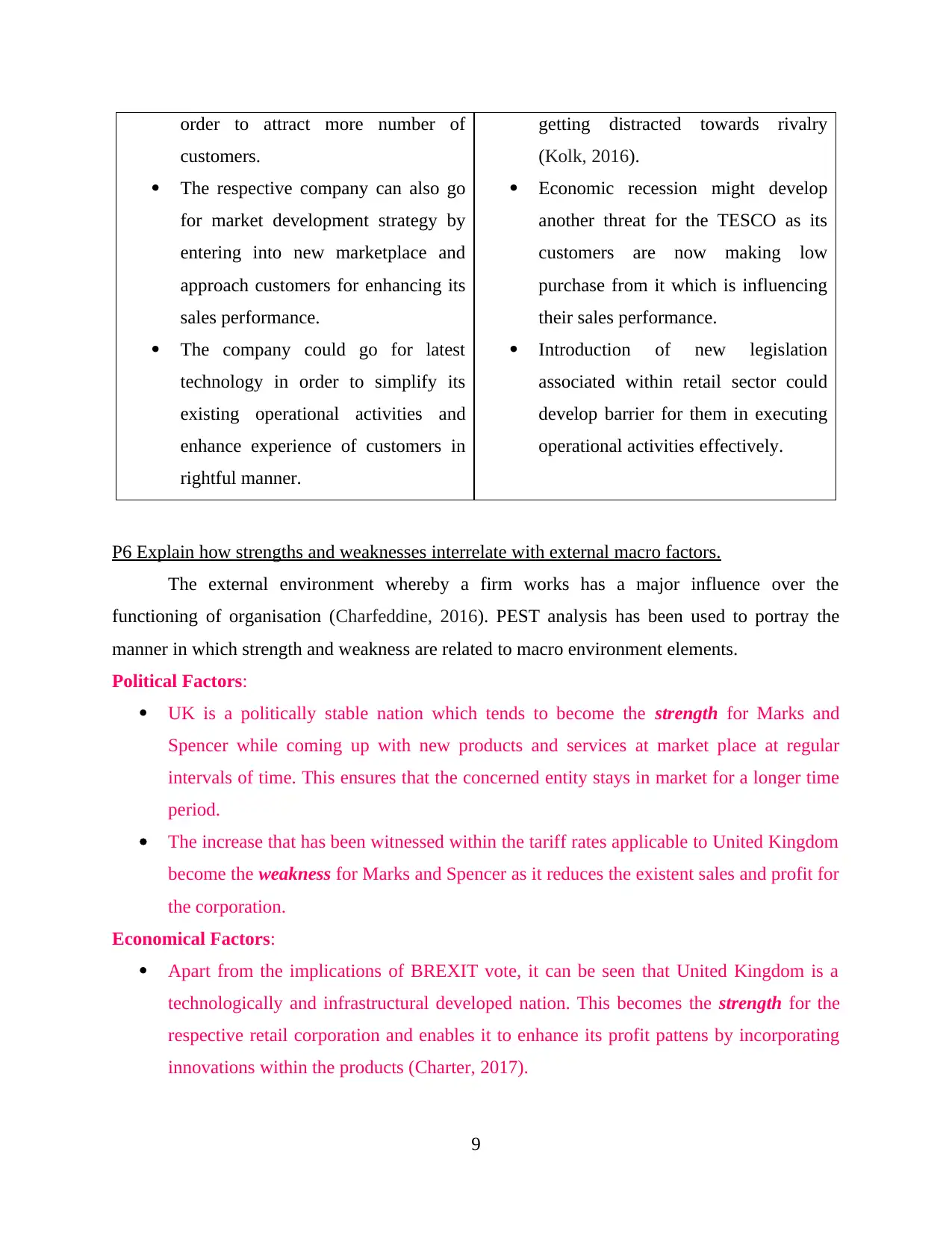
order to attract more number of
customers.
The respective company can also go
for market development strategy by
entering into new marketplace and
approach customers for enhancing its
sales performance.
The company could go for latest
technology in order to simplify its
existing operational activities and
enhance experience of customers in
rightful manner.
getting distracted towards rivalry
(Kolk, 2016).
Economic recession might develop
another threat for the TESCO as its
customers are now making low
purchase from it which is influencing
their sales performance.
Introduction of new legislation
associated within retail sector could
develop barrier for them in executing
operational activities effectively.
P6 Explain how strengths and weaknesses interrelate with external macro factors.
The external environment whereby a firm works has a major influence over the
functioning of organisation (Charfeddine, 2016). PEST analysis has been used to portray the
manner in which strength and weakness are related to macro environment elements.
Political Factors:
UK is a politically stable nation which tends to become the strength for Marks and
Spencer while coming up with new products and services at market place at regular
intervals of time. This ensures that the concerned entity stays in market for a longer time
period.
The increase that has been witnessed within the tariff rates applicable to United Kingdom
become the weakness for Marks and Spencer as it reduces the existent sales and profit for
the corporation.
Economical Factors:
Apart from the implications of BREXIT vote, it can be seen that United Kingdom is a
technologically and infrastructural developed nation. This becomes the strength for the
respective retail corporation and enables it to enhance its profit pattens by incorporating
innovations within the products (Charter, 2017).
9
customers.
The respective company can also go
for market development strategy by
entering into new marketplace and
approach customers for enhancing its
sales performance.
The company could go for latest
technology in order to simplify its
existing operational activities and
enhance experience of customers in
rightful manner.
getting distracted towards rivalry
(Kolk, 2016).
Economic recession might develop
another threat for the TESCO as its
customers are now making low
purchase from it which is influencing
their sales performance.
Introduction of new legislation
associated within retail sector could
develop barrier for them in executing
operational activities effectively.
P6 Explain how strengths and weaknesses interrelate with external macro factors.
The external environment whereby a firm works has a major influence over the
functioning of organisation (Charfeddine, 2016). PEST analysis has been used to portray the
manner in which strength and weakness are related to macro environment elements.
Political Factors:
UK is a politically stable nation which tends to become the strength for Marks and
Spencer while coming up with new products and services at market place at regular
intervals of time. This ensures that the concerned entity stays in market for a longer time
period.
The increase that has been witnessed within the tariff rates applicable to United Kingdom
become the weakness for Marks and Spencer as it reduces the existent sales and profit for
the corporation.
Economical Factors:
Apart from the implications of BREXIT vote, it can be seen that United Kingdom is a
technologically and infrastructural developed nation. This becomes the strength for the
respective retail corporation and enables it to enhance its profit pattens by incorporating
innovations within the products (Charter, 2017).
9
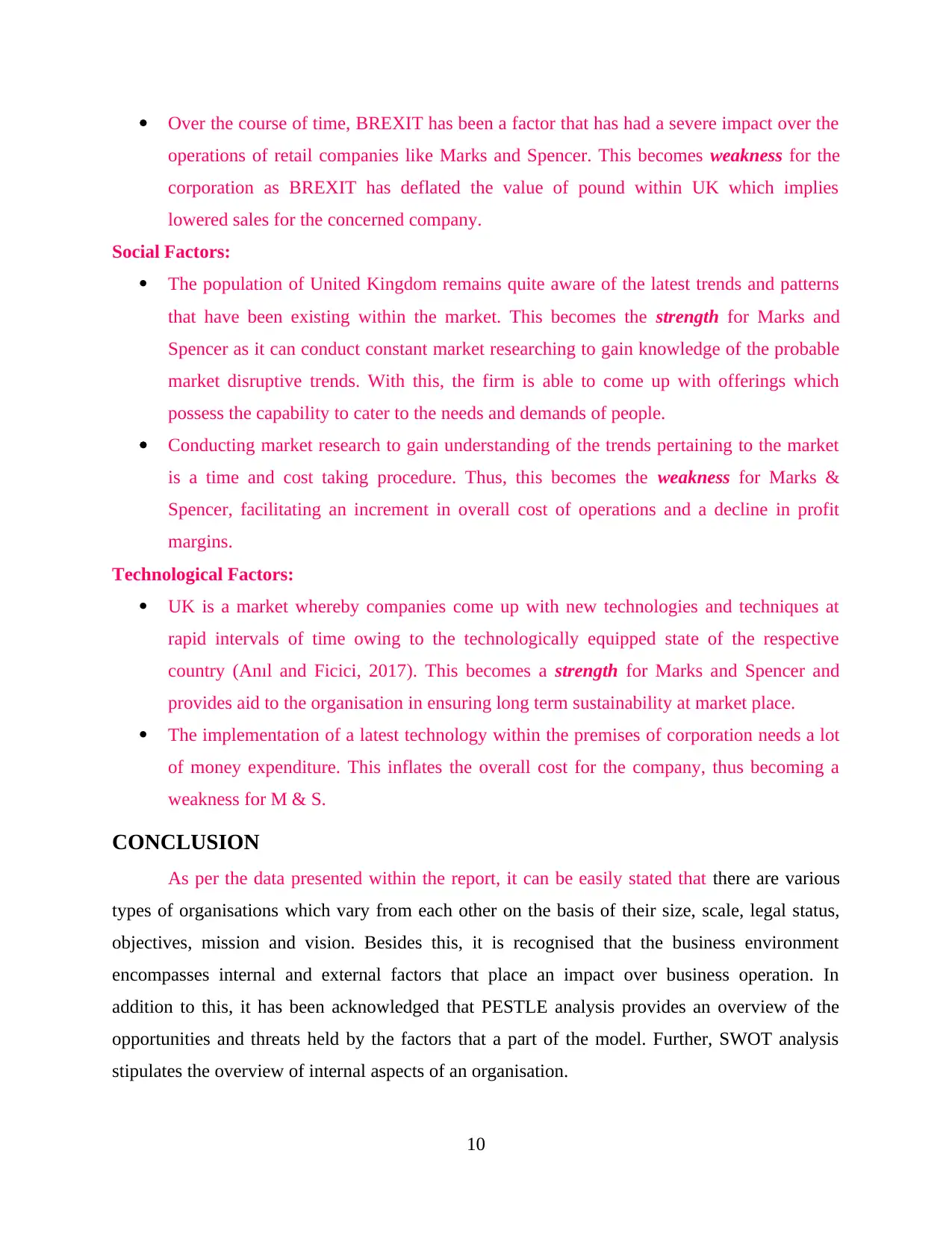
Over the course of time, BREXIT has been a factor that has had a severe impact over the
operations of retail companies like Marks and Spencer. This becomes weakness for the
corporation as BREXIT has deflated the value of pound within UK which implies
lowered sales for the concerned company.
Social Factors:
The population of United Kingdom remains quite aware of the latest trends and patterns
that have been existing within the market. This becomes the strength for Marks and
Spencer as it can conduct constant market researching to gain knowledge of the probable
market disruptive trends. With this, the firm is able to come up with offerings which
possess the capability to cater to the needs and demands of people.
Conducting market research to gain understanding of the trends pertaining to the market
is a time and cost taking procedure. Thus, this becomes the weakness for Marks &
Spencer, facilitating an increment in overall cost of operations and a decline in profit
margins.
Technological Factors:
UK is a market whereby companies come up with new technologies and techniques at
rapid intervals of time owing to the technologically equipped state of the respective
country (Anıl and Ficici, 2017). This becomes a strength for Marks and Spencer and
provides aid to the organisation in ensuring long term sustainability at market place.
The implementation of a latest technology within the premises of corporation needs a lot
of money expenditure. This inflates the overall cost for the company, thus becoming a
weakness for M & S.
CONCLUSION
As per the data presented within the report, it can be easily stated that there are various
types of organisations which vary from each other on the basis of their size, scale, legal status,
objectives, mission and vision. Besides this, it is recognised that the business environment
encompasses internal and external factors that place an impact over business operation. In
addition to this, it has been acknowledged that PESTLE analysis provides an overview of the
opportunities and threats held by the factors that a part of the model. Further, SWOT analysis
stipulates the overview of internal aspects of an organisation.
10
operations of retail companies like Marks and Spencer. This becomes weakness for the
corporation as BREXIT has deflated the value of pound within UK which implies
lowered sales for the concerned company.
Social Factors:
The population of United Kingdom remains quite aware of the latest trends and patterns
that have been existing within the market. This becomes the strength for Marks and
Spencer as it can conduct constant market researching to gain knowledge of the probable
market disruptive trends. With this, the firm is able to come up with offerings which
possess the capability to cater to the needs and demands of people.
Conducting market research to gain understanding of the trends pertaining to the market
is a time and cost taking procedure. Thus, this becomes the weakness for Marks &
Spencer, facilitating an increment in overall cost of operations and a decline in profit
margins.
Technological Factors:
UK is a market whereby companies come up with new technologies and techniques at
rapid intervals of time owing to the technologically equipped state of the respective
country (Anıl and Ficici, 2017). This becomes a strength for Marks and Spencer and
provides aid to the organisation in ensuring long term sustainability at market place.
The implementation of a latest technology within the premises of corporation needs a lot
of money expenditure. This inflates the overall cost for the company, thus becoming a
weakness for M & S.
CONCLUSION
As per the data presented within the report, it can be easily stated that there are various
types of organisations which vary from each other on the basis of their size, scale, legal status,
objectives, mission and vision. Besides this, it is recognised that the business environment
encompasses internal and external factors that place an impact over business operation. In
addition to this, it has been acknowledged that PESTLE analysis provides an overview of the
opportunities and threats held by the factors that a part of the model. Further, SWOT analysis
stipulates the overview of internal aspects of an organisation.
10
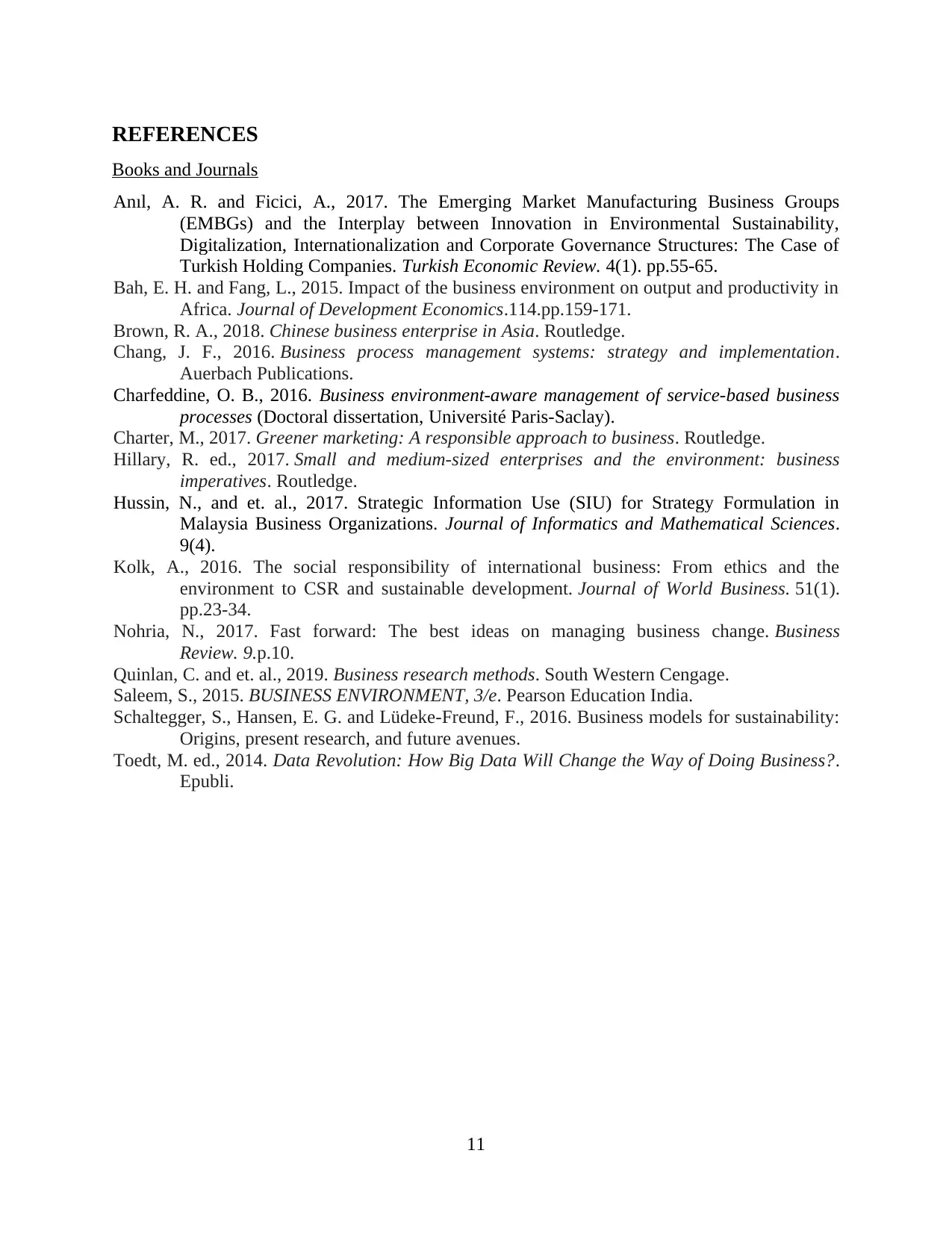
REFERENCES
Books and Journals
Anıl, A. R. and Ficici, A., 2017. The Emerging Market Manufacturing Business Groups
(EMBGs) and the Interplay between Innovation in Environmental Sustainability,
Digitalization, Internationalization and Corporate Governance Structures: The Case of
Turkish Holding Companies. Turkish Economic Review. 4(1). pp.55-65.
Bah, E. H. and Fang, L., 2015. Impact of the business environment on output and productivity in
Africa. Journal of Development Economics.114.pp.159-171.
Brown, R. A., 2018. Chinese business enterprise in Asia. Routledge.
Chang, J. F., 2016. Business process management systems: strategy and implementation.
Auerbach Publications.
Charfeddine, O. B., 2016. Business environment-aware management of service-based business
processes (Doctoral dissertation, Université Paris-Saclay).
Charter, M., 2017. Greener marketing: A responsible approach to business. Routledge.
Hillary, R. ed., 2017. Small and medium-sized enterprises and the environment: business
imperatives. Routledge.
Hussin, N., and et. al., 2017. Strategic Information Use (SIU) for Strategy Formulation in
Malaysia Business Organizations. Journal of Informatics and Mathematical Sciences.
9(4).
Kolk, A., 2016. The social responsibility of international business: From ethics and the
environment to CSR and sustainable development. Journal of World Business. 51(1).
pp.23-34.
Nohria, N., 2017. Fast forward: The best ideas on managing business change. Business
Review. 9.p.10.
Quinlan, C. and et. al., 2019. Business research methods. South Western Cengage.
Saleem, S., 2015. BUSINESS ENVIRONMENT, 3/e. Pearson Education India.
Schaltegger, S., Hansen, E. G. and Lüdeke-Freund, F., 2016. Business models for sustainability:
Origins, present research, and future avenues.
Toedt, M. ed., 2014. Data Revolution: How Big Data Will Change the Way of Doing Business?.
Epubli.
11
Books and Journals
Anıl, A. R. and Ficici, A., 2017. The Emerging Market Manufacturing Business Groups
(EMBGs) and the Interplay between Innovation in Environmental Sustainability,
Digitalization, Internationalization and Corporate Governance Structures: The Case of
Turkish Holding Companies. Turkish Economic Review. 4(1). pp.55-65.
Bah, E. H. and Fang, L., 2015. Impact of the business environment on output and productivity in
Africa. Journal of Development Economics.114.pp.159-171.
Brown, R. A., 2018. Chinese business enterprise in Asia. Routledge.
Chang, J. F., 2016. Business process management systems: strategy and implementation.
Auerbach Publications.
Charfeddine, O. B., 2016. Business environment-aware management of service-based business
processes (Doctoral dissertation, Université Paris-Saclay).
Charter, M., 2017. Greener marketing: A responsible approach to business. Routledge.
Hillary, R. ed., 2017. Small and medium-sized enterprises and the environment: business
imperatives. Routledge.
Hussin, N., and et. al., 2017. Strategic Information Use (SIU) for Strategy Formulation in
Malaysia Business Organizations. Journal of Informatics and Mathematical Sciences.
9(4).
Kolk, A., 2016. The social responsibility of international business: From ethics and the
environment to CSR and sustainable development. Journal of World Business. 51(1).
pp.23-34.
Nohria, N., 2017. Fast forward: The best ideas on managing business change. Business
Review. 9.p.10.
Quinlan, C. and et. al., 2019. Business research methods. South Western Cengage.
Saleem, S., 2015. BUSINESS ENVIRONMENT, 3/e. Pearson Education India.
Schaltegger, S., Hansen, E. G. and Lüdeke-Freund, F., 2016. Business models for sustainability:
Origins, present research, and future avenues.
Toedt, M. ed., 2014. Data Revolution: How Big Data Will Change the Way of Doing Business?.
Epubli.
11
1 out of 13
Related Documents
Your All-in-One AI-Powered Toolkit for Academic Success.
+13062052269
info@desklib.com
Available 24*7 on WhatsApp / Email
![[object Object]](/_next/static/media/star-bottom.7253800d.svg)
Unlock your academic potential
© 2024 | Zucol Services PVT LTD | All rights reserved.




